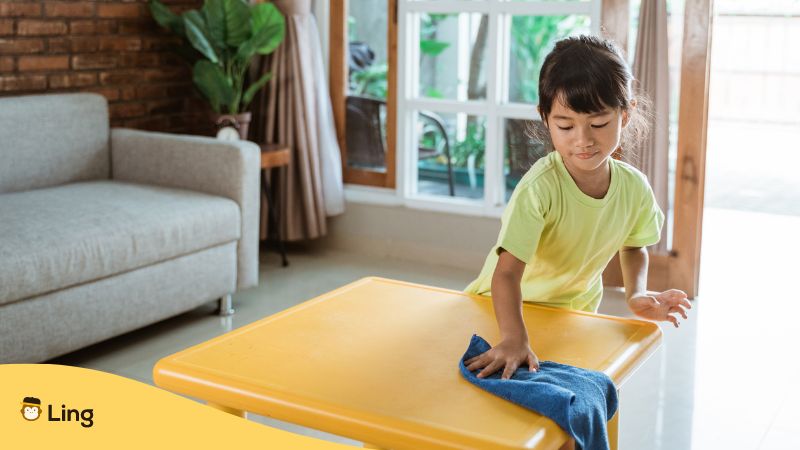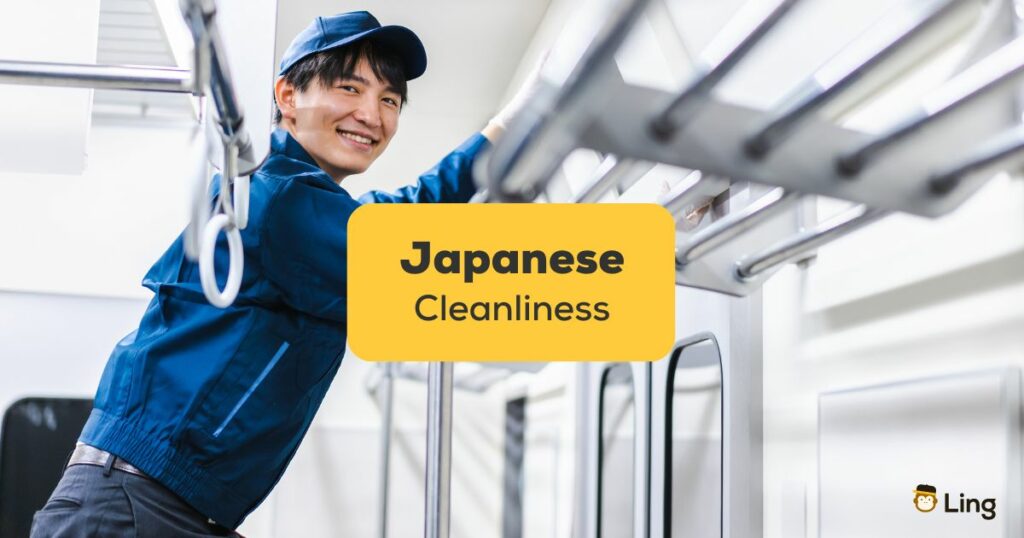You know that feeling when you walk into a flawless Japanese home and everything just feels… right? That’s not by accident! Japanese cleanliness is practically a national obsession, and frankly, it’s pretty impressive. I’ve traveled Japan far and wide, and I’m still stunned by the squeaky-clean streets and spotless public restrooms.
But don’t let this intimidate you! Japanese cleanliness might seem new to you, but trust me, it’s easier to get the hang of than you think. Plus, learning Japanese cleaning terms helps a ton! Ready? Let’s get to it!
Table Of Contents
What Is Japanese Cleanliness?
Alright, first things first—the Japanese word for “cleanliness” is seiketsu (清潔). But listen, it’s deeper than sparkling surfaces (though those train station floors could give you some ideas!). Japanese words like seiketsu, kiyome (清め), meaning “purity,” and seiso (清掃) meaning “orderliness” have a much stronger connotation here.
Think about it: Have you ever walked into a perfectly organized room and just felt… good? Things have their place, there’s no clutter, and it’s oddly calming. Yeah, that’s the kind of vibe they’re going for in Japan. Think of it as a clean space, clean mind kind of thing.
But cleanliness in Japan is also wrapped up in respect. A spotless space means you care about yourself, others sharing it, and the space itself. It’s about being considerate! Like, those cute handkerchiefs everyone carries? Not just a fashion statement—it’s way more hygienic than sneezing all over the train.
Ever seen a Japanese train leave late? I didn’t think so, but if there is, it’s very seldom! That famous efficiency is partly due to this whole focus on everything (and everyone) having its proper place and time.
Cleanliness Rooted In Japanese History And Religion
Now, this obsession of Japanese people with cleanliness didn’t just appear overnight! Japan’s ancient traditions have a lot to do with it.
Do you know those gorgeous Shinto shrines with hand-washing fountains called chozuya? Well, the whole washing ritual before you enter is about purification, that sense of kiyome we talked about. It’s a centuries-old tradition!
And here’s another fun fact: Buddhist monks weren’t just meditating all day or preparing for the Japanese tea ceremony (although, wouldn’t that be nice?). Cleaning was (and still is!) seen as a way to practice mindfulness, focusing on the present moment. Who knew scrubbing a floor could be so zen?
Want something truly mind-blowing? All the way back in the Edo Period (that’s the 1600s!), Japan had public health campaigns and organized trash disposal. They were seriously ahead of the curve on the whole “clean cities, healthy people” idea.
Cleanliness In Everyday Life In Japan
Ever tried finding a trash can on a Tokyo street? It’s like a scavenger hunt, and you’ll probably lose! Most Japanese people and expats who have adapted to Japan’s cleanliness culture take their trash home to throw away later.
Speaking of personal responsibility, get this—kids in Japan actually clean their own classrooms! It’s called osouji, and it totally blows my mind after the half-hearted “cleaning” we did back in school. They sweep, mop, and everything at a very young age! No wonder most Japanese adults feel responsible about keeping even the smallest spaces spotless.
You may wonder, “Why do Japanese homes seem so uncluttered?” It’s intentional minimalism, which is part of Japanese culture! Less stuff naturally means less to clean up, which makes life simpler. Plus, finding what you need without rummaging through piles of junk feels amazing.
But this isn’t only about tidiness but also about preparing for a new beginning, reflecting deeply on the Shinto and Buddhist values of respecting one’s living space.
Have you noticed those Japanese words I mentioned? You can learn more about the Japanese language with the Ling app! This fun language-learning app can help you master 60+ languages in the easiest way possible. You can get it from Google Play and App Store and use it completely free!

Japan’s Spotless Public Spaces
So, Japanese cleanliness is only focused on homes, right? Wrong! That focus on tidiness isn’t just for indoors—it seriously extends to all those Japanese public places, too. Wanna know how they keep things so spotless?
Let me give you an example: if you’ve ever ridden a Japanese train, especially the Shinkansen (those bullet trains!), you know what I’m talking about. Those floors could double as mirrors (well, almost!). But how do they do it? It’s a mix of behind-the-scenes work and everyday habits.
Japan’s Public Transport Secret
You won’t see overflowing trash cans on Japanese subways—efficient cleaning crews are on duty. Their turnaround time is mind-blowing, especially at major train stations like Tokyo or Shinagawa.
But it’s the people using the trains that are the real stars. Most people carefully carry their trash until they find a proper place to bin it. It’s just the way things are done!
Parks, Temples, Tourist Hotspots
Have you ever been to Shibuya Crossing, packed with thousands of people during rush hour? Yet, it somehow stays spotless.
The same goes for temples after big events, like during cherry blossom season at Kiyomizu-dera in Kyoto—always immaculate. It’s that ingrained expectation of leaving a space as good (or better!) than you found it.
Neighborhood Clean-Ups
Get this—volunteering to clean up your local park is actually a way people socialize! It’s called chiiki seiso, and often happens on weekend mornings. It’s about building community pride and having a shared purpose, and sometimes, there are even snacks afterward!
The World Cup Phenomenon
How about those viral photos and videos of Japanese fans cleaning up stadiums after World Cup matches in 2022? Yeah, that blew a lot of people’s minds (including mine), but it’s actually not unusual here.
During the recent Tokyo Olympics, international volunteers were surprised by how little trash there was to collect. In my opinion, big events or not, tidying up public areas is just…a normal thing to do. Do you agree?

The Cultural Values Behind Japan’s Cleanliness
So, those spotless parks and subway stations are more than elbow grease. There are actually cultural values hidden in plain sight. Here’s the deeper stuff:
- It’s About Respect: This is huge. Leaving a space spotless shows respect—for yourself, for everyone else who uses that space, and for the place itself. Think of it as extending the same courtesy you’d want in your own home or place to the wider world.
- Mindfulness in the Everyday: Cleaning isn’t always fun, but there’s a certain zen to it when you fully focus on the task. Japanese cleaning often involves attention to detail, kind of like a mini-meditation session in the middle of your day. No wonder those spotless corners have a calming effect!
- Cleanliness & Consideration: Carrying a handkerchief instead of sniffing on the train? Considerate! Pocketing your takeout wrapper because there’s no bin nearby? That’s showing respect for the shared space and making everyone’s life a little easier. It’s also about hygiene—something heavily emphasized during flu season especially.
What Are Japanese Methods For Cleanliness?
Okay, enough about spotless subways—how do Japanese folks actually do it? I’ve seen their houses, and it’s like… a whole other level of clean. Turns out, there are a bunch of traditions, tools, and smart habits behind it all. Let’s get into it.
1. Genkan – The Entryway Ritual
You wanna know how those anime scenes where someone yells Tadaima! (I’m home!) feel so real? It’s the genkan! It’s that lowered entryway where shoes come OFF before you step inside.
Think of it like a line in the sand—outside dirt stays OUTSIDE. Often, there’s even a little shelf called a getabako for keeping those shoes tidy.
Why’s this such a big deal? Well, it keeps the floors inside pristine! Who wants to track whatever they stepped in on the street?
It’s a genius way to protect their often-beautiful tatami mats or polished wooden floors. Plus, doesn’t taking our shoes off at the end of the day feel SO GOOD?
2. KonMari Method – Decluttering
Ever heard of Marie Kondo? She’s practically the queen of tidiness, and her whole “spark joy” thing started here in Japan. So, yeah, decluttering is huge, and Zen Buddhism plays a big role in it.
Instead of just shoving stuff in closets, the KonMari method is all about whether something makes you happy. If it doesn’t, out it goes (with a grateful goodbye, of course)!
I’ll admit, it sounded kinda corny at first. But you know what? It does make sense. Less stuff, less cleaning, and you only keep things you truly cherish.
3. Tatami Mat Maintenance
Those traditional mats made from woven rice straw are gorgeous, but they need TLC. They get vacuumed super gently (no rough scratching here!) and aired out in the sun a few times a year.
Seems like a hassle, but it’s worth it. Prevents mold, keeps the air quality good, and makes those tatami last for years. And doesn’t the smell of sun-dried tatami just take you back to a classic Japanese inn?
4. 5S Methodology In Housekeeping
Alright, this one sounds kinda boring, but bear with me! The 5S—they’re all about efficiency. They started in Japanese factories, and now people even use them in their homes. Basically, they’re Sort, Set in Order, Shine (that’s cleaning!), Standardize, and Sustain.
So, what does that mean at home? Ditch whatever you don’t need, have a place for everything, clean regularly, then make the effort a daily habit! Kinda makes sense… I mean, my apartment in Manila could use a bit of this 5S magic myself.
5. Osoji – The Big Year-End Clean
Think spring cleaning, but cranked up to eleven! Right around New Year’s, it’s time for osoji—a tradition of giving your home a super deep clean. We’re talking full-on scrubbing, washing windows, and airing out everything.
It’s like pushing the reset button before the year begins. I gotta admit, there’s something satisfying about starting the New Year in a squeaky-clean space.
6. Seasonal Cleaning Rituals
It’s not just New Year’s that gets the cleaning treatment. There’s Haru Souji in the spring—a time to declutter and freshen things up. Think of it as a way to shake off winter and welcome new beginnings with a clean and unburdened space.
And here’s something cool: Hinokishin. It’s a Tenrikyo religious practice of offering voluntary services—including cleaning up public spaces like parks. It’s a beautiful way to give back and keep that community spirit of cleanliness going strong.
7. Technology in Cleaning
Okay, time for some gadgets! You know those Roombas, the little robot vacuums? They’re super popular in Japan. People also love high-tech air purifiers to keep the air fresh and free of bacteria.
Think of it like this: these tools let you automate some boring stuff. That frees up time for the detail-oriented, hands-on cleaning Japanese people excel at. Japanese tradition and rituals meet innovation!
8. Waste Management And Recycling
You gotta admire the dedication here! Japan has super strict rules for sorting trash—burnables, non-burnables, recyclables, the works. It takes some learning, but the payoff is huge. It makes you more mindful about what you consume and encourages recycling.
The Japanese society often comes together for clean-up drives, too. It builds a sense of shared responsibility for their neighborhoods. Makes me wonder why we don’t do this more in other countries.
Useful Japanese Phrases For Cleaning
Look at you, gettin’ all into this Japanese cleanliness thing! But hey, wanna take it up a notch? Trust me, I’ve seen those confused looks at the cleaning aisle—knowing how to ask for stuff is half the battle. So, let’s get you armed with some Japanese cleaning vocabulary!
| English | Japanese | Pronunciation |
|---|---|---|
| Can you clean this? | これをきれいにしてもらえますか? | Kore o kirei ni shite moraemasu ka? |
| Where is the soap? | 石鹸はどこですか? | Sekken wa doko desu ka? |
| Please bring me a broom. | ほうきを持ってきてください。 | Houki o motte kite kudasai. |
| Do you have a mop? | モップはありますか? | Moppu wa arimasu ka? |
| I need to disinfect this area. | このエリアを消毒する必要があります。 | Kono eria o shoudoku suru hitsuyou ga arimasu. |
| Could you hand me that sponge? | そのスポンジを渡してもらえますか? | Sono suponji o watashite moraemasu ka? |
| I’m looking for a brush. | ブラシを探しています。 | Burashi o sagashite imasu. |
| Do we have any detergent? | 洗剤はありますか? | Senzai wa arimasu ka? |
| I want to polish the floor. | 床を磨きたいです。 | Yuka o migakitai desu. |
| Please wipe the table. | テーブルを拭いてください。 | Teeburu o fuite kudasai. |
| It’s important to sanitize hands. | 手を殺菌することが大切です。 | Te o sakkin suru koto ga taisetsu desu. |
| How do you deodorize this room? | この部屋をどうやって消臭しますか? | Kono heya o douyatte shoushuu shimasu ka? |
| Can you help me scrub this? | これをこすって助けてもらえますか? | Kore o kosutte tasukete moraemasu ka? |
| Please sweep the entrance. | 入り口を掃いてください。 | Iriguchi o haite kudasai. |
| Where should I put the dustpan? | ちりとりはどこに置けばいいですか? | Chiritori wa doko ni okeba ii desu ka? |
Embrace Japan’s Clean Vibe!
So yeah, Japanese cleanliness is a mindset, a respect for the spaces you share with others, and even a way to take care of yourself. Honestly, I’ve started bringing some of these ideas back home with me—it’s amazing how much better my house feels after a good clean!
Maybe you won’t become a full-on cleaning ninja overnight. But hey, now you’ve got a deeper understanding of this part of Japanese culture and some useful phrases to back it up. That’s pretty awesome, right? Let me know if you end up trying any of these Japanese cleaning methods at home—I’d love to hear how it goes!



































































